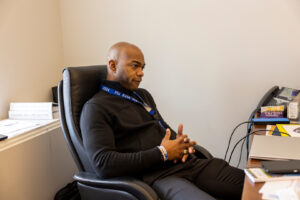
By Charlie Quick and Sonia Kharbanda
Rep. Cedrick Frazier (DFL-New Hope) is the lead legislator working on a bill to update 2023 legislation that sought to limit how school resource officers and faculty members could restrain students.
The most controversial aspect of this issue is the use of prone restraints, which involves holding a person face-down on the ground, as Derek Chauvin was holding George Floyd when he was killed. The 2023 bill aimed to limit school resource officers to use prone restraints only in near-death situations. After the bill was passed, many law enforcement agencies removed their officers from schools, believing that vague legislation prevented them from doing their job. The new legislation aims to bring school resource officers back into schools by clarifying their responsibilities and developing a uniform, statewide policy around school resource officer’s roles.
On Monday, March 1, the State House passed the fix and sent it to the Senate for a vote. Frazier sat down with ThreeSixty reporters Sonia Kharbanda and Charlie Quick on Feb. 19, to discuss how this impacts young people. They also spoke with Attorney General Keith Ellison.
This interview has been edited for length and clarity.
How can SROs determine when it is necessary to use a prone restraint?
So they’ll still be guided by their 609.06–[the police] statute for use of force. I think one of the clear things is we created a clear bright line as to when SROs can actually engage students. They cannot engage students for disciplinary purposes. … Because what we’ve learned, historically, when you look at the data, a lot of the engagements that happened [are] … because maybe a faculty member is bringing them in to deal with classroom management. And that’s not their role, so we expect that the bright line … will lessen quite substantially those engagements that SROs are going to have with students.
Why should SROs be allowed to perform prone restraints?
In situations where, for example, there’s an active shooter, if there’s any type of violence. … When law enforcement is thinking about a prone restraint, they’re thinking about a tool that they use to maybe gather someone and put them in handcuffs. Obviously, the prone restraints that we hear from educational advocates [are] … about a specific prone restraint, actually holding the student down for an extended period of time, that could cause issues with breathing. So in the bill, we address if someone is put in a prone restraint by an SRO, the duration has to be accounted for. We want to make sure that there’s a focus on keeping our kids as safe as possible.
Prior to 2023, we banned the use of chokeholds, breath-impacting holds, and restrictive holds for SROs. So even today, an officer couldn’t put a student in a chokehold or something that would restrict their breath. That was already something that was banned after the murder of George Floyd.
What inspired you to change the original bill?
The reason was there was no framework. There was no statewide uniformity. So essentially, what we would have had to rely on in the current bill. Well, let me back up. Two things: There is the bill that was passed in 2023. But then there’s two [attorney general] opinions.
The AG opinion essentially said that SROs are bound by 609.06 subdivision three, which is the use of force standards. … That wasn’t the intent of the advocates who were working on that bill. They wanted there to be some restrictions and limitations on when those can be used. The current bill that we’re drafting puts in place a framework that would allow for those types of parameters for using prone restraints. That was what prompted me to do it, to ensure that we were reaching the real intent. And the real intent was to make sure that we have things in place to keep our kids safe.
What would you tell students who worry that this bill would make them more unsafe in schools?
I would tell them the bright line creates better protections, I think, than the 2023 [bill] that relied … on the threat of harm or a threat of death, because it creates a clear bright line. Obviously, [SROs] can only engage with [students] if there’s a situation [that] was [potentially] violent, or criminal activity, but not within the school setting or day-to-day in a classroom setting.
For example, a teacher can’t say hey, “Hakeem won’t go to the lunchroom, SRO please come and escort Hakeem to the lunchroom.” That’s their job. That’s not the job of an SRO. Those are the types of engagement that we’ve seen were escalating into situations that could be harmful to our kids, and we want to make sure that those don’t happen.
Sonia and Charlie worked with Minnesota Reformer reporters Madison McVan and Deena Winter to finish their story. This story was completed at ThreeSixty’s Winter News Team: Capitol Edition in February 2024, where high school journalists covered important legislative issues, impacting Minnesota youth. Read more stories here.
